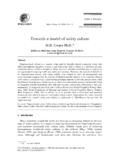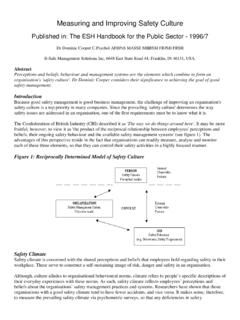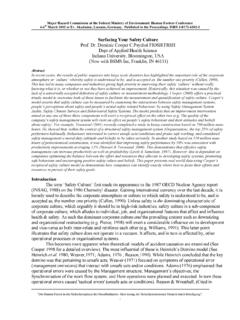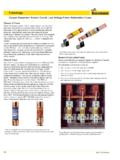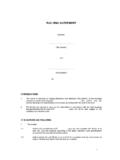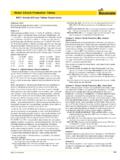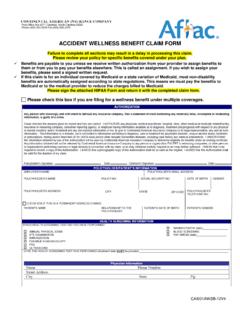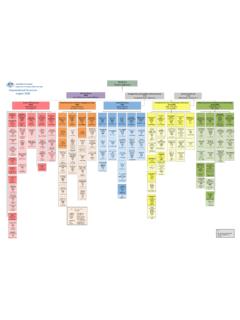Transcription of Impact of Management Committment-Cooper-013
1 * Prof. Dominic cooper BSMS Inc. 6648 East State Road 44, Franklin, Indiana, 46131, USA Tel: +1 (317) 736 8980 E-mail: ASSE- 0307-013 The Impact of Management s Commitment on Employee Behavior: A Field Study Prof. Dominic cooper * C. Psychol. , BSMS Inc. 6648 East State Road 44, Franklin, Indiana, 46131, USA. ABSTRACT Behavioral safety was implemented in a nickel refinery over a 93-week period with 275 employees, plus contractors. Measurement focused on managerial commitment behaviors and employee safety behaviors. Safety behavior improved by 40%. Lost time injuries reduced by in the first year, reducing to Zero in the second. Minor injuries reduced by 35%. Multiple regression showed managerial commitment impacted 35% on employee safety behavior. The timing and magnitude of Impact suggests Management must continually demonstrate their commitment to safety.
2 KEYWORDS Managerial Commitment, Safety behavior, Goal-setting, Feedback. 1. INTRODUCTION Top performing companies express high commitment to safety by developing a process in which the workforce can participate, and which can be implemented and monitored so both Management and the workforce can receive feedback1. A systematic behavioral safety process fulfils these conditions. The intention is to focus workers attention and action on their safety behavior to avoid injury. Interventions are aimed entirely upon the observable interactions between safety behavior and the working environment. Behavioral safety attempts to identify those unsafe behaviors implicated in the majority of injuries. These behaviors and/or their proxies ( , hoses left lying across walkways) are developed into specific behavioral checklists.
3 Trained observers use these to monitor and record people s work behavior on a regular basis ( , daily). Derived from the observation results, Percent safe scores provide feedback so people can track their progress against self-set, assigned or participative improvement goals2. Feedback mechanisms include verbal feedback at the point of observation, graphical charts and/or written performance summaries so corrective actions can be taken3,4. Results indicate significant reductions in injury rates are possible within a relatively short time5 with the Impact lasting for many years6. Those companies implementing behavioral safety possess a high degree of organizational commitment to safety7. However, the commitment of individual manager s to the organization s safety goals and the behavioral safety process is a significant factor8.
4 Managers need to provide the necessary resources, give the workforce the authority to run and manage the process alongside the usual safety Management systems, and actively support the process. In many instances this does not occur. 2. Management S COMMITMENT Managerial commitment is defined as "engaging in and maintaining behaviors that help others achieve a goal 8. Broadly speaking, measurement can be undertaken in two ways: Direct questions are asked of managers9 or their commitment behaviors are monitored10. Not many managers admit they are uncommitted to safety when asked, whereas behavior provides the ultimate proof of commitment10. An extensive search of the psychological, managerial and safety literatures reveals the existing managerial commitment evidence is almost entirely based on perceptual questionnaires or semi-structured interviews.
5 With few exceptions8,11,12 little empirical work has assessed the actual Impact of managerial commitment behaviors on employee behavior. Management Levels: Although unclear, the available evidence suggests different Management levels exert different effects on employee behavior. For example, in a Dutch questionnaire study of 207 workers on 15 construction sites13, it was found that senior managers exert a greater influence on employee motivation to behave safely than supervisors do. Conversely, a Canadian American Society of Safety Engineers Middle East Chapter 7th Professional Development Conference & Exhibition Kingdom of Bahrain, March 18-22, 2006 ASSE 0307-013 The Impact of Management s Commitment on Employee Behavior: A Field Study 2 study14,15 using a questionnaire survey with 23,615 production workers, suggest supervisors exert a greater influence on employee behavior than senior plant managers do.
6 These two examples suggest the effects of Management s commitment are likely to be moderated by situational aspects such as the prevailing safety culture16, industrial sector and type of organizational structure17. 3. STUDY AIMS The purpose of the current study was to ascertain the Impact that managerial support behaviors exerted on employees safety behavior, utilizing senior, middle and front-line Management behavioral checklists over a 93-week period in a Nickel Refinery. 4. METHOD Participants and Setting: The refinery contained eight main departments on a 55-acre site, employing approximately 275 personnel. The five main production departments operated a continuous 24-hour, 3 x 8 hour rotating shift system, with two shifts 'resting' at any one time. Shipping operations worked a 2 x 8 hour shift system (am and pm). Site support functions comprised administration, laboratories, medical facilities, engineering maintenance, and safety, who worked a 'normal' five-day, 39-hour week.
7 Transitional contractors from seven companies also participated ( , welders, fitters, canteen staff, cleaners, etc.). Intervention Design: This study utilized a repeated-measures time series design with 43 work groups across three separate interventions, over 93 weeks. Intervention 1 lasted 29 weeks, with 31 and 33-week durations for interventions 2 and 3, respectively (see Figure 1). The primary measurement variables focused on employee safety behavior and managerial supportive behavior. Injury rates and their associated costs comprised the secondary variable used to assess the efficacy of the interventions. Figure 1: Experimental Design Intervention 1 (n=29 weeks) Intervention 2 (n=31 weeks) Intervention 3 (n=33 weeks) Baseline (A) Intervention (B) Baseline (A) Intervention (B) Baseline (A) Intervention (B) Safety Performance Measures: The site was divided into 27 observation areas across eight main departments, containing 43 work-groups.
8 Based on analyses of the company s historical injury records for the previous two years, behavioral checklists for the 27 areas were developed. Each contained a maximum of 20 behaviors ( , personnel are holding the handrails when using stairs) pertaining to the work area of interest. These were placed into various categories ( , housekeeping, personal protective equipment, etc.) to facilitate analyses and feedback. Each checklist contained three columns: Safe; Unsafe, and Unseen. The safe and unsafe columns were used to calculate an Observed Percent Safe score, which was used as the primary dependent variable in this study. The unseen column was used when behavior did not take place during an observation session ( it could not be observed). Management 's Commitment: Managers themselves identified the Management commitment behaviors.
9 The resulting behavioral support checklists did not change throughout the duration of the study. Senior Management s checklist contained 11 items (See Figure 2 for an example), and middle Management s contained 16 items. The managers were trusted to complete these once per week on a self-report basis. A visible ongoing support (VOS) proxy measure provided an indicator of front-line Management s commitment. Completed by employee observers weekly, these contained seven items. Each contained two columns (Yes & No), so an Observed Percent Support score could be calculated. Figure 2: Senior Management Commitment Index Injuries: The lost-time injury (LTI) and minor injury rate (inclusive of occupational health exposures) were the company s primary outcome measures used to assess the effectiveness of the behavioral safety process.
10 The site calculated these based on the number of incidents per 200,000 hrs worked. 5. PROCEDURE Obtaining Employee Participation: Briefings with all site personnel took place prior to any training or implementation taking place (inclusive of contractors), to seek employee participation. At these, the workforce indicated their most serious safety concerns and the most common unsafe behaviors they engaged in. Actions on the concerns were completed soon after the briefing sessions and then publicized to reinforce employee participation. 1 Accompanied an observer during an observation 2 Attended a workgroup feedback meeting 3 Discussed safety performance with employee(s) (one-to-one) 4 Discussed line Management on-going support 5 Developed plans for corrective actions 6 Ensured that some corrective actions were closed 7 Approved funding for safety improvement(s) 8 Reviewed progress with Management team and/or SHE advisor 9 Conducted an incident investigation (as required) 10 Attended a safety training course 11 Conducted safety related training ASSE 0307-013 The Impact of Management s Commitment on Employee Behavior: A Field Study 3 The unsafe behaviors were used to help develop behavioral checklists.

